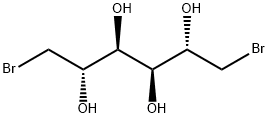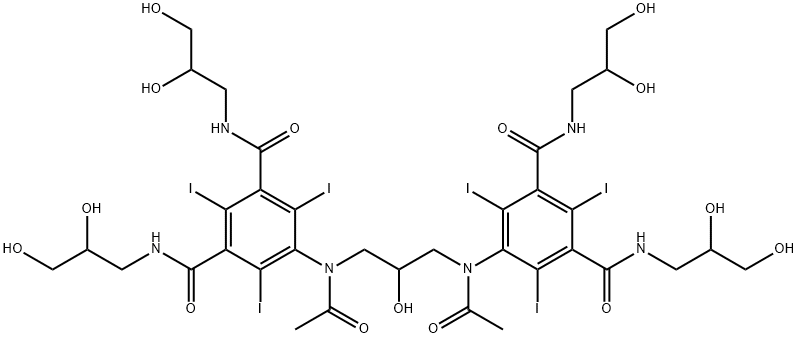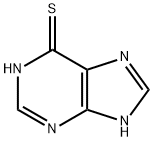1,6-DIBROMO-1,6-DIDEOXY-D-MANNITOL
- CAS NO.:488-41-5
- Empirical Formula: C6H12Br2O4
- Molecular Weight: 307.97
- MDL number: MFCD00045046
- EINECS: 207-676-8
- SAFETY DATA SHEET (SDS)
- Update Date: 2024-10-28 16:48:35

What is 1,6-DIBROMO-1,6-DIDEOXY-D-MANNITOL?
Originator
Myelobromol,Hormonchemie,W. Germany,1967
The Uses of 1,6-DIBROMO-1,6-DIDEOXY-D-MANNITOL
Antineoplastic.
What are the applications of Application
1,6-Dibromo-1,6-dideoxy-D-mannitol is an intermediate for saccharide synthesis
Definition
ChEBI: Mitobronitol is an alcohol and an organobromine compound.
Manufacturing Process
750 g D-mannitol are dissolved in 4,000 ml of a 48% aqueous hydrogenbromide solution, whereupon the solution thus obtained is saturated at 0°Cwith gaseous hydrogen bromide until a HBr content of 69 to 70% is achieved.The reaction mixture is heated for 6 hours at 60°C in an autoclave, is thendecolorized with charcoal, extracted with 1 liter chloroform twice and dilutedwith 7 liters of water. The pH value of the solution is adjusted by means ofsodium bicarbonate to1 to 2. The crystals precipitated after cooling for a dayare filtered and washed with water until free from acid. 250 g crude 1,6-dibromo-1,6-didesoxy-D-mannitol are obtained. MP 176° to 178°C. Analysis:Br % = 52 (calc.: 51.9).
250 g of the crude DBM are dissolved in 2.5 liters of hot methanol and ondecolorizing and filtration 2.5 liters of dichloroethane are added. 220 g ofcrystalline DBM are obtained. MP 178°C. Br % = 51.9.
Therapeutic Function
Cancer chemotherapy
General Description
White powder.
Air & Water Reactions
Insoluble in water.
Reactivity Profile
A halogenated alcohol. Flammable and/or toxic gases are generated by the combination of alcohols with alkali metals, nitrides, and strong reducing agents. They react with oxoacids and carboxylic acids to form esters plus water. Oxidizing agents convert them to aldehydes or ketones. Alcohols exhibit both weak acid and weak base behavior. They may initiate the polymerization of isocyanates and epoxides.
Fire Hazard
Flash point data for 1,6-DIBROMO-1,6-DIDEOXY-D-MANNITOL are not available, but 1,6-DIBROMO-1,6-DIDEOXY-D-MANNITOL is probably combustible.
Properties of 1,6-DIBROMO-1,6-DIDEOXY-D-MANNITOL
| Melting point: | 176-178° |
| Boiling point: | 511.2±50.0 °C(Predicted) |
| Density | 1.8987 (rough estimate) |
| refractive index | 1.4840 (estimate) |
| storage temp. | −20°C |
| pka | 12.61±0.20(Predicted) |
| EPA Substance Registry System | Mitobronitol (488-41-5) |
Safety information for 1,6-DIBROMO-1,6-DIDEOXY-D-MANNITOL
Computed Descriptors for 1,6-DIBROMO-1,6-DIDEOXY-D-MANNITOL
Abamectin manufacturer
New Products
4-AMINO-TETRAHYDRO-PYRAN-4-CARBOXYLIC ACID HCL 4-(Dimethylamino)tetrahydro-2H-pyran-4-carbonitrile 4-Aminotetrahydropyran-4-carbonitrile Hydrochloride (R)-3-Aminobutanenitrile Hydrochloride 3-((Dimethylamino)methyl)-5-methylhexan-2-one oxalate 1,4-Dioxa-8-azaspiro[4.5]decane 5-Bromo-2-nitropyridine Nimesulide BP Aceclofenac IP/BP/EP Diclofenac Sodium IP/BP/EP/USP Mefenamic Acid IP/BP/EP/USP Ornidazole IP Diclofenac Potassium THOMAIND PAPER PH 2.0 TO 4.5 1 BOX BUFFER CAPSULE PH 9.2 - 10 CAP SODIUM CHLORIDE 0.1N CVS ALLOXAN MONOHYDRATE 98% PLATINUM 0.5% ON 3 MM ALUMINA PELLETS (TYPE 73) LITHIUM AAS SOLUTION 2-Bromo-1-(bromomethyl)-3-chloro-5-nitrobenzene 2-Bromo-3-nitroaniline N-(3-Hydroxypropyl)-N-methylacetamide 3-Bromo-6-chloropyridazine 4-ethyl-3-nitrobenzoic acidRelated products of tetrahydrofuran








You may like
-
 1-Methyl-6-oxo-1,6-dihydropyridazine-3-carbonitrile 98%View Details
1-Methyl-6-oxo-1,6-dihydropyridazine-3-carbonitrile 98%View Details
99903-60-3 -
 88491-46-7 98%View Details
88491-46-7 98%View Details
88491-46-7 -
 1823368-42-8 98%View Details
1823368-42-8 98%View Details
1823368-42-8 -
 2-(3-(tert-butyl)phenoxy)-2-methylpropanoic acid 1307449-08-6 98%View Details
2-(3-(tert-butyl)phenoxy)-2-methylpropanoic acid 1307449-08-6 98%View Details
1307449-08-6 -
 Ethyl 3-(furan-2-yl)-3-hydroxypropanoate 25408-95-1 98%View Details
Ethyl 3-(furan-2-yl)-3-hydroxypropanoate 25408-95-1 98%View Details
25408-95-1 -
 2-Chloro-5-fluoro-1-methoxy-3-methylbenzene 98%View Details
2-Chloro-5-fluoro-1-methoxy-3-methylbenzene 98%View Details
1805639-70-6 -
 1784294-80-9 98%View Details
1784294-80-9 98%View Details
1784294-80-9 -
 Lithium ClavulanateView Details
Lithium ClavulanateView Details
61177-44-4